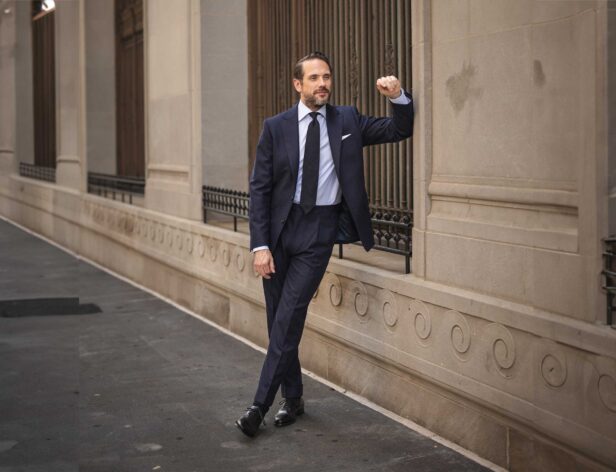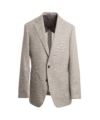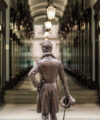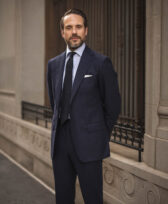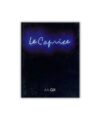

Share
How To Put Outfits Together, The Easy Way
When it comes to the so-called rules of style and how to put outfits together, I’m honestly of two minds. There’s the part of me that’s like, yes, of course, there’s a well-documented process and method of how to do things and what works. And if you believe in and follow that process, you are sure to succeed. This color goes with that one. Your bow tie fabric should always match your lapel fabric. And so on and so forth.
But then there’s the part of me that’s like, do I really have to follow these rules? Who made them up? Won’t we all look the same if we’re just painting by number? Beyond that, I’ve always been someone who goes mostly by feel with certain things—matters of menswear being one of them. Because even if I follow the formula to the letter and my outfit looks “right” in the academic sense, well maybe I just don’t feel right, you know?
There is certainly a balance point when it comes to rule-following and going by feel. There’s also quite a strong case to be made for the benefits of both approaches. But the reality is that sometimes you’re in a rut. Sometimes you’re in a hurry. Sometimes you feel like you have nothing to wear. It’s in those instances that the best possible thing you can do is to get back to basics. So if there was a simple formula for how to dress well and look good, it would go something like this.
But First…
Let me start out by saying that in this post we’re going to using a classic sport coat and trousers approach rather than a suit. Why, you ask? Well, a suit is often too formal for most occasions, especially nowadays. Hear me out.
Yes, you may be inclined to argue the classic menswear maxim that it’s much better to be overdressed than underdressed. But I would rebut that statement by pointing out that in many situations, adhering to that mantra would make you “that guy.” And being “that guy” is never good. So while a suit could definitely make you “that guy,” a sport coat and trousers outfit will look smart and put together without even a whiff of try-hard. Now let’s begin.
Choose A Seasonally Appropriate Jacket
Although there are alleged four-season or perennial fabrics, a true menswear guy will take a much more considered approach when it comes to cloth. Different fabrics possess different qualities that make them particularly well-suited for one season over another, including weight and its ability to keep heat in or out.
For the spring and summer months, you should choose a jacket in a lightweight and breathable fabric. Cotton is wonderful for spring as most cotton jacketing has a bit more heft while still being breathable. Hopsack—a type of wool weave—is also a great option, which I particularly love due to its wonderful texture.
As the temperatures rise into the summer months, you’ll want to start favoring linen and fresco as they’re much lighter and more breathable. You’ll also want to consider an unlined jacket when it’s hotter out as it will more easily allow your body heat to escape and any cool breeze to get through.
When the temperatures start to drop in the fall and winter, it’s time for your jacket fabrics to get a little to a lot heavier. Flannels, tweeds, and heavier weight wools work pretty universally through all of the colder months. Even a heavy tweed is a great option for the fall as it makes for a pretty smart transitional jacket.
Layer In A Collared Shirt
The next step is to select the correct shirt. The most important thing here is to identify the formality of the occasion or event you’re getting dressed for as that will inform the decision you make related to three key considerations: collar style, fabric, and pattern (or lack thereof).
For more dressed up scenarios, go with a classic spread collar in a solid color poplin or twill fabric. White will feel more crisp and clean, light blue for a touch less formality. For a more casual situation, choose a button-down collar in a classic Oxford cloth. A light blue OCBD is de rigueur, a fine micro-stripe for a little more interest, or a brushed cotton version for the most casual situations. To tone the formality even more, try a gingham or denim with a classic spread collar.
Stick To Basic Trousers
Trousers are the simplest part of this equation and, as such, it’s best to stick to the basics. Remember, we’re talking about how to put outfits together the easy way so limiting your choices to the tried and true will help you make a good decision quickly.
For business or dressier looks, I’d recommend going with a classic and versatile mid-gray wool or flannel depending on the season. In the business casual realm, khaki chinos should be your trousers of choice, though you may also opt for a khaki or navy cotton pair depending on the situation. And for your most casual looks, a well-fitting pair of medium blue denim jeans is a no-brainer.
Choose Good-Looking Leather Shoes
A great pair of shoes is the anchor of every outfit and deciding the appropriate pair to wear is directly tied, like your shirt, to the formality of the situation. For business or more formal affairs, always choose a dark Oxford. A fine dark brown or deep oxblood will always make sense, while for the most formal of fêtes black is your one and only.
For in-between dress codes, such as business casual, sharp casual, and the rest, go with a lighter oxford—perhaps something in a cognac or walnut—derbies, or a classic penny loafer. And for casual looks, once again derbies (though you might choose a pair with a nice pebble grain—broguing optional) or minimal leather sneakers.
The Bottom Line
Dressing well and putting together a good outfit isn’t difficult. And when you keep things simple, you never look like you’re trying too hard. There are, of course, infinite ways to skin this proverbial cat and you’re certainly welcome to tailor any part of this advice to meet your personal tastes and style preferences. Simply use it as a starting point the next time you put an outfit together and see what happens.
Thanks, as always, for reading.
